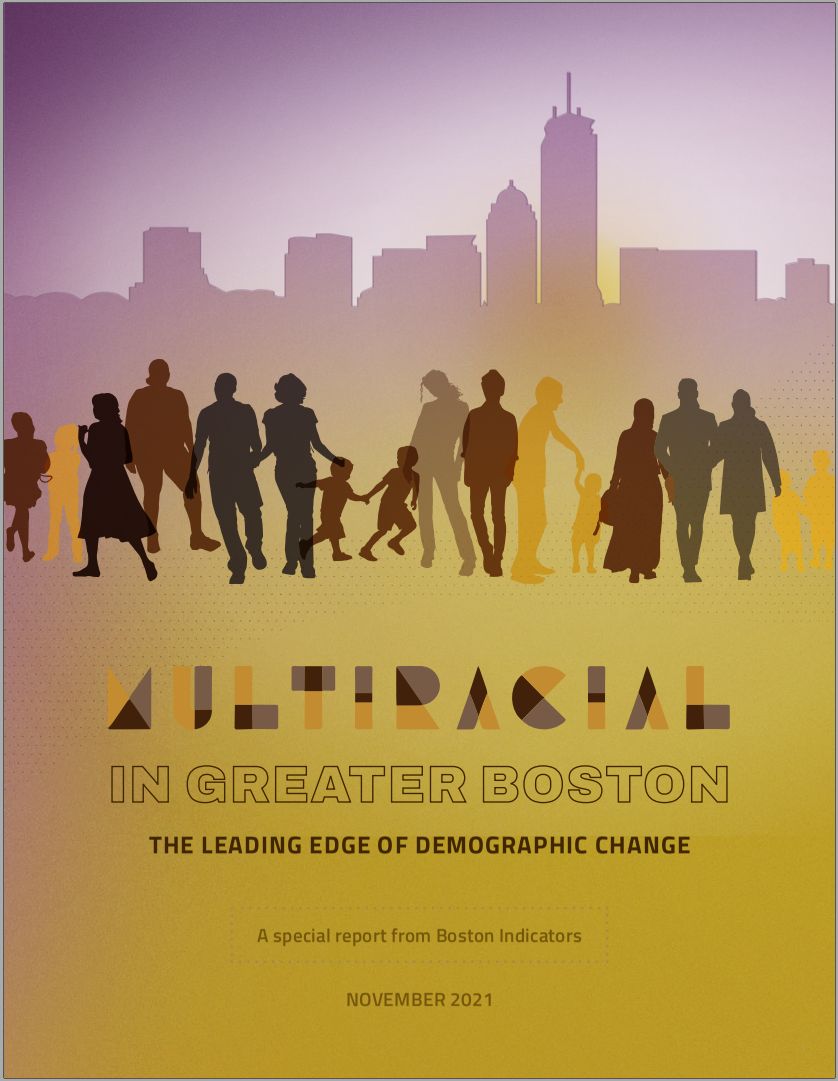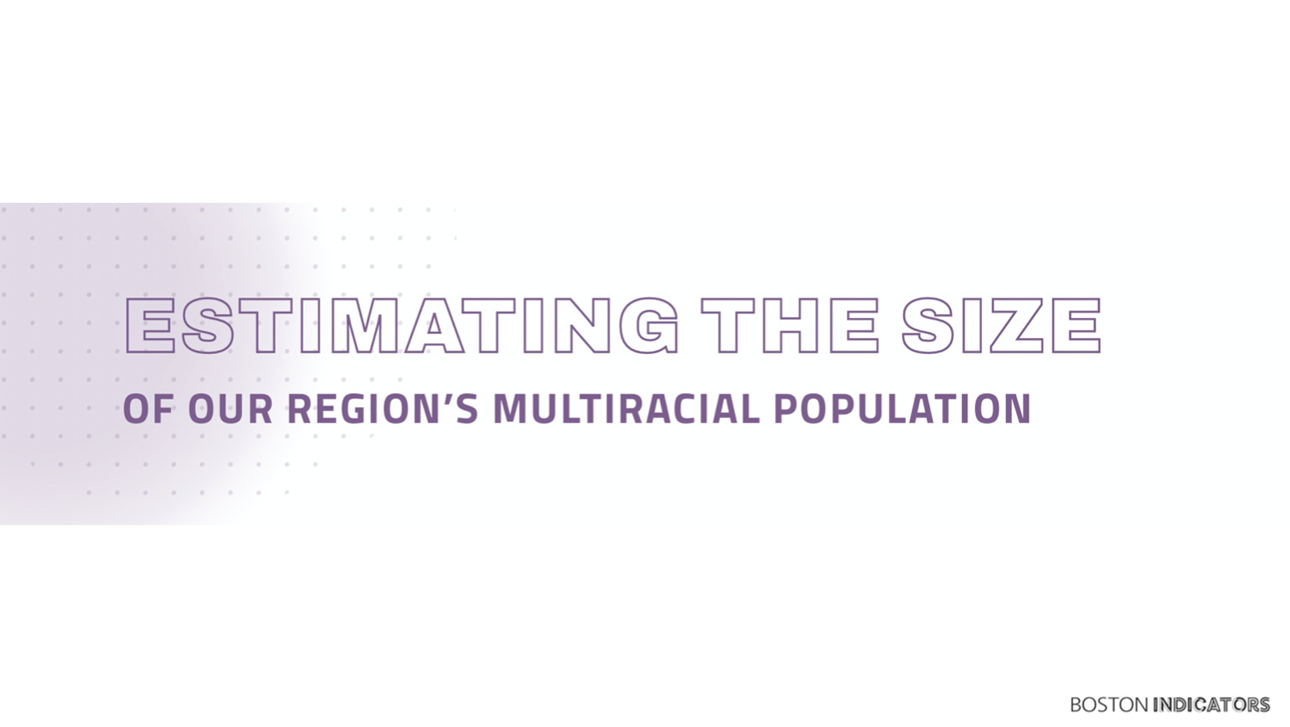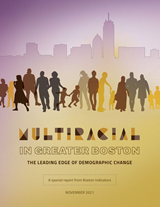Mattos pointed out that multiracial people have been part of the American scene practically since European arrival, though initially mostly via conquest, colonialism and enslavement. With that acknowledgement, he described Greater Boston’s current population breakdown by race, including people of mixed-race backgrounds. (Full report is online)
Driving the region’s diversity has been the increase in both immigration and interracial marriage since the late 1960s. The Immigration and Nationality Act of 1965 reduced immigration restrictions on many countries and the 1967 Supreme Court decision in Loving v. Virginia banned miscegenation laws nationwide. Mattos concluded by zooming in on the child and infant population in Greater Boston, where 20 percent of new babies born are of mixed race or Latino ethnicity; among these, half claim mixed Latino/non-Latino heritage. Looking only at babies living with two parents in the region, the number whose parents are of different racial or ethnic identity has quadrupled since 1980.
Because the Census Bureau considers Latino/Hispanic heritage as ethnicity, not race, things can get complicated. And do. The report points out ways in which common census reporting judgments may be distorting the counts of some populations. Regardless, the multiracial population promises to grow as this generation of future multiracial adults go on to have multiracial children of their own. Will an increasingly diverse population, with more blurring of racial categories, help us get beyond ethnic and racial strife? “These figures offer hope,” Mattos said, “but don’t guarantee equity on their own.”
To talk about this and issues both more philosophical and individual, Boston Indicators Director Luc Schuster introduced three panelists—all raised in Boston and of mixed-race heritage themselves, and working in areas where the issue of race is front and center. They shared some of their personal stories in tackling broader questions.
Suffolk County District Attorney Rachael Rollins’ parents were married shortly after the Loving decision. Her father’s people were from County Mayo, Ireland; her mother’s from Barbados. They experienced hatred and rejection over their relationship, Rollins said, but she credits her dual heritage for giving her strength: “The superpower of being biracial is that you can assimilate into any community. You can code switch. I call myself culturally ambidextrous,” she explained. “I am fluent in White Irish Male—and I mean that with all due respect. The skills I got growing up in a multicultural home are the skill set I need to succeed in my role.”
SPEAKERS & PANELISTS
- M. Lee Pelton, President & CEO, The Boston Foundation
- Trevor Mattos, Senior Research Manager, Boston Indicators
- Rachael Rollins, District Attorney, Suffolk County, Commonwealth of Massachusetts
- Zebulon Miletsky, Associate Professor of Africana Studies, Stony Brook University
- Peter Kiang, Professor & Director of Asian American Studies Program, UMass Boston
- Luc Schuster, Senior Director, Boston Indicators (Moderator)
Stony Brook University Associate Professor Zebulon Miletsky recalled that it wasn’t the easiest thing to grow up as a light-skinned biracial person in Roxbury but that the community was amazing. “It’s a strange phenomenon,” he observed, “being biracial and being aware that things we inherited, that happened before our time, dictate the complications and the power and nature of how things are now.” As a professor of Africana Studies, he has written extensively on the history of abolitionism, civil rights, and interracial marriage, especially in the Boston setting.
UMass-Boston Professor Peter Kiang also offered historical perspective, showing how some of today’s multiracial trends connect directly to past policy decisions. Data on intermarriages show there are notable patterns of partnership; for instance, in White/Asian couples it is much more common to find a White husband and Asian wife than vice versa. “If you think about the U.S. relationship to Asia in the 20th century,” he said, “it is defined by war. White male soldiers had interracial kids—starting in the Philippines, and through Japan, Korea, Vietnam….”
Other policies on immigration and other domestic issues have had equally profound impact. Kiang said, “The consequences of actions such as the Immigration Act of 1965 help us understand there are all kinds of long-term implications to policy decisions.” What if we made a policy decision now to make ethnic studies part of the K–12 curriculum, he suggested. Investing in people’s understanding of each other is “the only way we get beyond identity-fueled politics.”
We have to keep focused on policy, Rollins agreed. With a growing multiracial population, she said, “people may say, ‘Now everyone’s mixed and there’s no racism.’ No. There’s still a hierarchy of melanin—even within [groups]. Working in the criminal legal system, seeing wealth-based and race-based disparities every day—we can’t ignore these even as we improve inclusion…It is great that my children are raised in Roxbury and got to see Michelle Wu sworn in as mayor, with her two multicultural sons watching. There are lots of great things happening. But let’s not pretend there isn’t a lot more work to do.”





